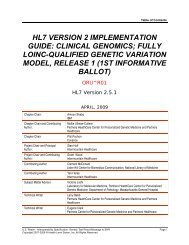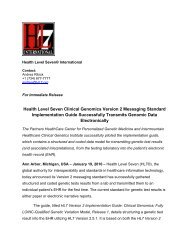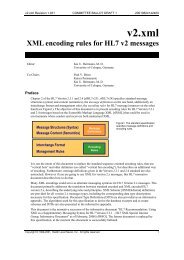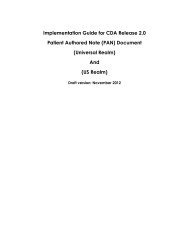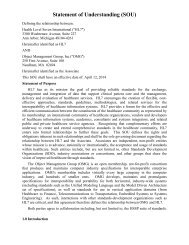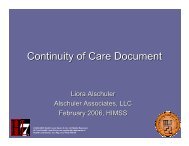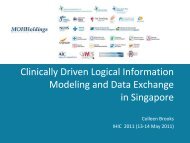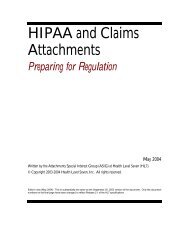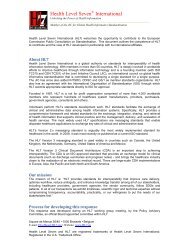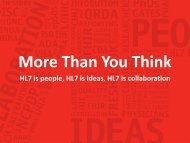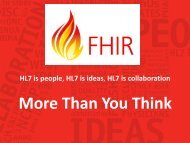HL7 CDA R2 AIS Implementation Guide
HL7 CDA R2 AIS Implementation Guide
HL7 CDA R2 AIS Implementation Guide
Create successful ePaper yourself
Turn your PDF publications into a flip-book with our unique Google optimized e-Paper software.
<strong>HL7</strong> Additional Information Specification <strong>Implementation</strong> <strong>Guide</strong><strong>CDA</strong><strong>R2</strong><strong>AIS</strong>0000R0301.1.3 No Site-Specific Variations in Content or FormatThe economic benefits of HIPAA and standards in general are obtained, in part, by creating auniversal specification. Providers will not have to maintain large libraries of variations ontransaction formats to meet the differing requirements of payers. It is intended that the formats inthis <strong>Implementation</strong> <strong>Guide</strong> meet the requirement for universality.This implementation guide and the Additional Information Specifications (<strong>AIS</strong>) introduces aconcept called "cardinality" which defines if a specific data element is required or optional andthe number of iterations that can be sent. Cardinality is explained in further detail in section 2.10.Where options exist in the <strong>HL7</strong> <strong>CDA</strong>, the <strong>Implementation</strong> <strong>Guide</strong> or <strong>AIS</strong> should definitivelyspecify which would be used. Occasionally, however, the senders need options to coveralternative use cases. When this occurs, the <strong>AIS</strong> specifies that one of the alternatives must besent. In these cases where such options exist in the <strong>AIS</strong>, the receivers will accept all of theoptions that exist. For example, the electronic attachment for ambulance has a data element calledbody weight. There are three different LOINC codes for body weight according to whether theweight was measured, estimated, or stated by the patient or an agent of the patient. Theattachment specifies the option to use any of the three LOINC codes.1.2 Electronic Supporting Documentation AuthorityIn most of the <strong>AIS</strong>'s, <strong>HL7</strong> describes the data that is both optional and required. While <strong>HL7</strong>provides the maximum list of possible data that could be sent, the choice of what is actually sentis determined by the circumstances of requesting and/or sending additional information. <strong>HL7</strong>specifies how to format the <strong>HL7</strong> <strong>CDA</strong> documents that are embedded within X12 transactions andcontain the prescribed information specified in this <strong>Implementation</strong> <strong>Guide</strong>.Initiatives to create new attachments will usually come from industry stakeholders through theaffiliated group of HIPAA Designated Standards Maintenance Organizations, the DSMO. Todetermine content, workgroups are formed by conducting national outreach to all stakeholders,including, but not limited to, all DSMO members. Members of the <strong>HL7</strong> Attachments SpecialInterest Group (ASIG) facilitate these workgroups. As the industry experts from the specificattachment type domain develop the content for an attachment, it is then shared with the ASIG in<strong>HL7</strong>. Following approval by ASIG, it is sent to the <strong>HL7</strong> membership for ballot and approvalbefore being offered to the Department of Health and Human Services (HHS) for consideration asa new attachment type under HIPAA.Coincident with the above process, the ASIG requests new LOINC codes to identify theattachment data components. LOINC codes are established and maintained by the LOINCCommittee.1.2.1 Documentation and Business Flow for Attachments (both Claims and PriorAuthorization)Figure 1.2-1 illustrates the relationship of the organizations, documents, transaction messages,and codes. The ASC X12 implementation guides determine the contents of the ASC X12transactions except for the BIN segment. They also specify the use of externally defined LOINCcodes in certain data fields. The <strong>HL7</strong> <strong>Implementation</strong> <strong>Guide</strong> defines the format of the <strong>CDA</strong>document in the BIN segment. Externally defined LOINC codes are used to identify the questionbeing asked and answered in specified data fields of the X12 277/278 and 275 transactions.Copyright © 1998-2007 Health Level Seven, Inc. All rights reserved.Release 3.0 Draft StandardPage 5March 2007




